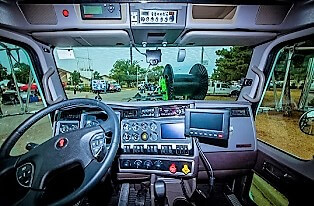 Sentinel Transportation LLC, a Delaware-based company that hauls crude oil and petroleum products across America, is a model of why advanced driver assistance systems make sense in the commercial fleet industry.
Sentinel Transportation LLC, a Delaware-based company that hauls crude oil and petroleum products across America, is a model of why advanced driver assistance systems make sense in the commercial fleet industry.
The Sentinel fleet has been using new vehicle safety technologies for more than a decade. Today, the company gathers data from radar, video and braking sensors to create a detailed picture of what is going on inside and outside its trucks.
Forward-facing and rear-facing in-cab cameras, along with a robust coaching and follow-up process, have changed driver behaviors, reduced crashes and ultimately lowered costs. Fatigue management, including ongoing training and sleep-apnea testing, when appropriate, are part of Sentinel's health and wellness program.
"We go multiple years without a preventable DOT crash," Sentinel President and CEO Adam Gregori said. "And that's with running 30 million miles a year."
Seeing Things from All Angles
Sentinel uses footage from in-cab cameras to coach drivers and enforce driving policies. While coaching and driver improvement are the main objectives of Sentinel's camera system, certain violations, such as handheld or hands-free cell phone use, are cardinal sins and cause for immediate termination. These violations and their consequences are clearly explained to all drivers upon hire and periodically thereafter.
Coaching events include:
- Not having at least one hand on the wheel
- Distractions that result from eating or drinking
- Not observing a proper following distance
After a violation, the driver has the opportunity to look at the video and usually agrees what he did was unsafe, said Sentinel Regional Safety Manager David Eicher.
Sentinel's 500-plus drivers annually undergo a blend of classroom, computer-based and hands-on training. The company also provides extensive new-hire training, typically lasting three to four weeks.
Andy Frisby works out of Sentinel's Hartford Terminal in southern Illinois. He has driven big rigs for 22 years, the last four with Sentinel. He said when he joined the company, he experienced culture shock. But the "bells and whistles" he had to adjust to have made him a safer driver, including:
- Speed-limiters to govern the speed of Sentinel trucks
- Technologies such as lane departure warning and tire monitoring systems
"With tires, the system monitors the pressure and temperature of each tire on the tractor," Frisby said. "This alerts the driver if a tire is under-inflated or overheating before it blows."
In a study conducted by the Federal Motor Carrier Safety Administration, fleets without lane departure warning installed on their vehicles experienced crashes at a 1.917 higher rate per million miles traveled than fleets with lane departure warning.
Vehicles with automatic emergency braking can reduce rear-end crashes by about 40%, according to estimates from the Insurance Institute for Highway Safety.
Why Safety Makes Dollars and Sense
Sentinel did an analysis of safety/risk statistics prior to implementing advanced safety technologies (2004-2006) versus post implementation (2014-2016). Todd Porter, vice president of safety and regulatory, and his team noted the following improvements:
| | Yearly Avg. | Yearly Avg. | Per Year |
| Crash Year | 2004-2006 | 2014-2016 | %Δ |
| Dept. of Transportation crashes | 21 | 11 | -49% |
| DOT crashes per million miles | 0.62 | 0.37 | -41% |
| Preventable DOT crashes | 4 | 2 | -58% |
| Preventable DOT crashes per million miles | 0.12 | 0.06 | -51% |
| Auto liability/general liability claims cost per mile | $0.013 | $0.004 | -65% |
| Auto liability/general liability claims % of revenue | 0.46% | 0.10% | -78% |
| Sentinel's safety systems % implemented | 15% | 92% | 500% |
Vehicle Safety Technology Implementation Still Voluntary
A 2016 agreement between federal regulators and leading automakers will speed standardization of automatic emergency braking in passenger vehicles, but in large trucks AEB and most other advanced driver assistance systems remain voluntary.
"As an industry we need to continue to put a higher priority on safety," Gregori said, adding that some company executives feel as long as they are within their budget for liability risk, they are willing to accept their current level of safety performance.
"There is a perception that these technologies and added expenses could negatively affect the profitability and overall financial results of the company, especially within smaller fleets," he said. "It's a conflict, frankly, in a lot of these fleets."
That is not the case at Sentinel.
"First, we have been at this long enough to see the long-term financial value of safety," Gregori said. "Second, advanced driver assistance systems reinforce our fundamental values and strengthen our safety message with employees. We don't just talk about safety, we actually believe in it and implement it within our equipment and culture every day."

 Sentinel Transportation LLC, a Delaware-based company that hauls crude oil and petroleum products across America, is a model of why advanced driver assistance systems make sense in the commercial fleet industry.
Sentinel Transportation LLC, a Delaware-based company that hauls crude oil and petroleum products across America, is a model of why advanced driver assistance systems make sense in the commercial fleet industry.